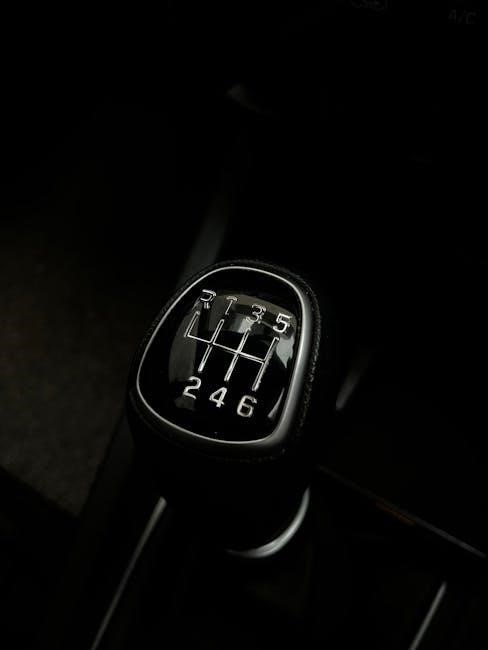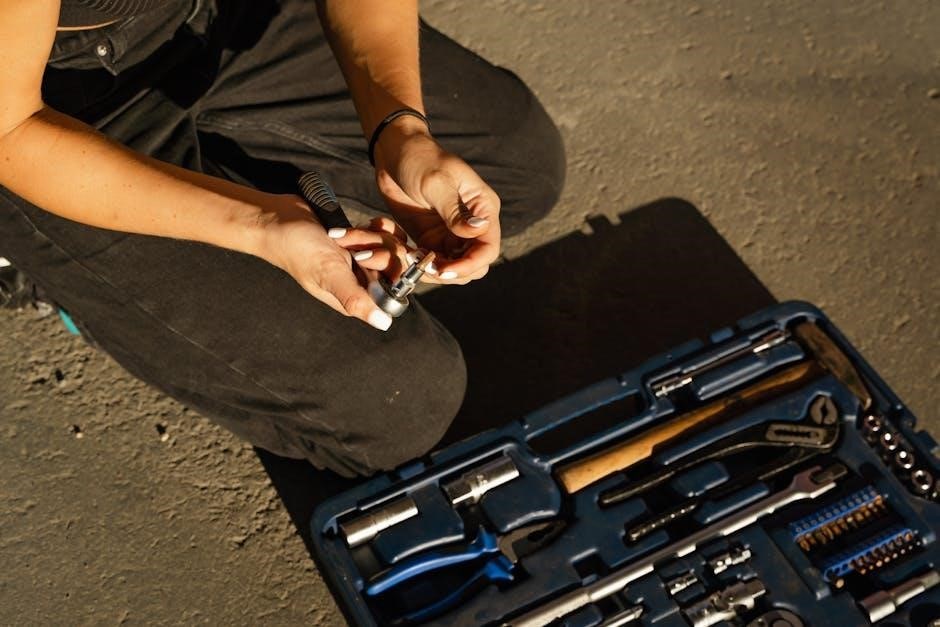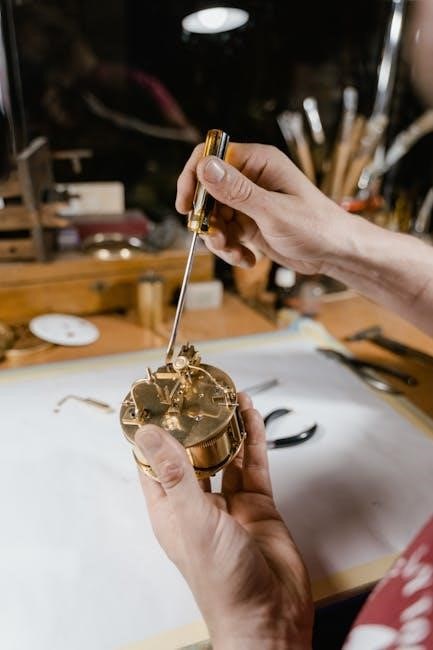Manual Transmission Stuck in Gear: Causes and Solutions
A manual transmission stuck in gear can stem from several issues, such as clutch problems, insufficient transmission fluid, or a faulty shift linkage․ Identifying the root cause is crucial for effective troubleshooting and repair․
Manual transmissions are complex systems that rely on precise mechanical components to function smoothly․ When a manual transmission becomes stuck in gear, it can be both frustrating and dangerous, leaving a vehicle immobilized or difficult to control․ This issue often arises due to a combination of factors, including wear and tear, improper maintenance, or sudden mechanical failure․ Common symptoms include difficulty shifting gears, a gear refusing to disengage, or the transmission locking in place entirely․ Understanding the underlying causes is essential for effective troubleshooting and repair․
Manual transmission issues can vary in severity, from minor adjustments to major overhauls․ Identifying the problem early can prevent further damage and costly repairs․ This section provides an overview of the common challenges associated with manual transmissions and sets the stage for exploring specific causes and solutions in detail․ By addressing these issues proactively, drivers can ensure their vehicle operates safely and efficiently․

Common Causes of a Manual Transmission Getting Stuck in Gear
A manual transmission can become stuck in gear due to issues like worn-out synchronizers, low transmission fluid levels, or a damaged shift linkage․ Clutch problems, such as a master cylinder failure, may also prevent proper gear disengagement․

Clutch-Related Issues
The clutch system is a critical component in manual transmissions, and its failure can directly cause the transmission to become stuck in gear․ If the clutch fails to disengage properly, the engine’s power continues to transfer to the gears, preventing smooth shifting․ This can occur due to a faulty clutch master or slave cylinder, where hydraulic fluid leaks or air enters the system, leading to a soft or spongy clutch pedal․ Additionally, a worn-out clutch disc or pressure plate can fail to disengage the engine from the transmission, causing the gears to remain locked; In some cases, the clutch pedal may not return to its normal position, further complicating the issue․ Over time, worn clutch facings or a warped flywheel can also contribute to improper disengagement․ Symptoms include grinding noises, difficulty shifting into gear, or the transmission staying in gear even when the clutch is pressed․ Addressing clutch issues promptly is essential to avoid further damage to the transmission system․
Low Transmission Fluid Level
A low transmission fluid level is a common cause of a manual transmission becoming stuck in gear․ Transmission fluid is essential for lubricating the gears and ensuring smooth shifting․ When the fluid level drops, the gears may not engage or disengage properly, leading to difficulty in shifting or the transmission becoming stuck․ If the fluid is old or contaminated, it can lose its lubricating properties, exacerbating the problem․ To check the transmission fluid level, locate the transmission dipstick, typically found under the hood, and ensure the level is within the recommended range․ If the level is low, top it off with the correct type of fluid specified in your vehicle’s manual․ However, if the fluid is dirty or degraded, it may need to be replaced entirely․ Ignoring low transmission fluid can lead to more severe damage, such as worn gears or synchronizers, so addressing this issue promptly is crucial for maintaining your transmission’s health․

Damaged or Worn Shift Linkage
A damaged or worn shift linkage is another common reason why a manual transmission might become stuck in gear․ The shift linkage connects the gearshift to the transmission, translating the driver’s inputs into gear changes․ Over time, the linkage can wear out or become misaligned, disrupting communication between the gearshift and the transmission․ This can result in gears not engaging or disengaging properly, causing the transmission to stick․ Symptoms of a faulty shift linkage include difficulty shifting gears, a loose or vague gearshift feel, or the transmission not responding to gear changes․ To diagnose this issue, inspect the shift linkage for signs of damage, rust, or wear․ If the linkage is damaged, it may need to be repaired or replaced․ Proper adjustment of the shift linkage is also crucial to ensure smooth gear transitions․ Addressing this issue early can prevent further damage to the transmission and ensure reliable shifting performance․
Worn Synchronizers
Worn synchronizers are a common cause of a manual transmission becoming stuck in gear․ Synchronizers are critical components that ensure smooth gear transitions by equalizing the speed of the gears and the shafts․ Over time, these components can wear out due to friction, high mileage, or aggressive driving habits․ When synchronizers wear down, they fail to properly engage or disengage gears, leading to difficulty shifting or the transmission becoming stuck in a specific gear․ Symptoms of worn synchronizers include grinding noises during gear changes, a “catching” sensation when shifting, or gears slipping out unexpectedly․ If left unaddressed, worn synchronizers can cause further damage to the gearbox, requiring costly repairs․ Inspecting and replacing worn synchronizers is essential to restore smooth gear transitions and prevent the transmission from getting stuck․ Regular maintenance and avoiding excessive wear on the transmission can help prolong the life of the synchronizers and overall gearbox health․

Internal Gearbox Damage
Internal gearbox damage is a severe issue that can cause a manual transmission to become stuck in gear․ This damage often results from high mileage, poor maintenance, or excessive stress on the gearbox․ Over time, the gears and bearings inside the transmission can wear out or become misaligned, leading to mechanical failures․ If the gears are chipped, cracked, or stripped, they may not engage or disengage properly, causing the transmission to lock in a specific gear․ In some cases, debris from worn components can interfere with the gear mechanism, further complicating the problem․ Symptoms of internal gearbox damage include unusual noises, vibrations, or resistance when attempting to shift gears․ Addressing this issue typically requires disassembling the transmission for a thorough inspection and repair or replacement of damaged parts․ Ignoring internal damage can lead to catastrophic failure, making it essential to address the problem promptly to avoid costly repairs and ensure the transmission operates smoothly․

Troubleshooting Steps for a Stuck Manual Transmission
Begin by assessing symptoms like difficulty shifting or gear locking․ Check the clutch pedal’s full release and ensure the transmission fluid level is adequate․ Inspect the shift linkage for damage or misalignment and test the synchronizers’ functionality․ If issues persist, professional diagnostic tools may be necessary to identify internal damage or electrical faults, ensuring proper repairs and restoring smooth gear transitions․

Checking Transmission Fluid Level and Condition
Checking the transmission fluid level and condition is a critical step in diagnosing a stuck manual transmission․ Locate the transmission fluid dipstick, typically found under the hood, and pull it out․ Wipe it clean with a lint-free cloth and insert it back to get an accurate reading․ The fluid level should be between the “MIN” and “MAX” marks․ If the level is low, add the recommended type of transmission fluid․ Inspect the fluid’s color and consistency—it should be light amber and smooth․ Dark or gritty fluid indicates contamination and requires a fluid change․ Low or dirty fluid can cause gears to stick due to insufficient lubrication․ If the fluid appears degraded or the level is incorrect, address these issues promptly to prevent further damage to the transmission system․ Regular fluid checks can help maintain optimal performance and avoid gear-sticking problems․ Always refer to your vehicle’s manual for specific instructions․
Inspecting the Shift Linkage and Adjustment
Inspecting the shift linkage is essential to identify issues that may cause the manual transmission to become stuck in gear․ Start by locating the shift linkage, typically connected to the transmission and the gearshift․ Check for any visible damage, wear, or loose connections․ If the linkage is bent, corroded, or has excessive play, it can prevent proper gear engagement․ Adjust the linkage by loosening the locking nut and turning the adjustment screw to ensure it aligns correctly with the transmission․ Tighten the nut once the proper alignment is achieved․ If the linkage is damaged, replace it immediately to avoid further complications․ Additionally, lubricate the linkage and its connections to ensure smooth operation․ A misaligned or worn-out shift linkage can disrupt gear shifting, leading to the transmission becoming stuck․ Regular inspection and adjustment can prevent such issues and maintain smooth gear transitions․ Always consult your vehicle’s manual for specific adjustment procedures․
Examining the Clutch System
Examining the clutch system is a critical step in diagnosing a manual transmission stuck in gear․ The clutch plays a vital role in disengaging the engine from the transmission, allowing smooth gear shifts․ If the clutch fails to release properly, it can prevent the transmission from shifting gears effectively․ Start by inspecting the clutch pedal for any signs of damage or wear․ Check the pedal’s range of motion and ensure it returns to its normal position after being pressed․ Next, examine the clutch master and slave cylinders for any leaks or damage, as fluid leaks can impair clutch operation․ Additionally, inspect the clutch plate for excessive wear or warping, which can prevent proper disengagement․ If the clutch shows signs of failure, replacing it may be necessary․ A faulty clutch can lead to the transmission becoming stuck in gear, making it difficult or impossible to shift․ Regular maintenance of the clutch system can help prevent such issues and ensure smooth gear transitions․ Always refer to your vehicle’s manual for specific instructions on clutch inspection and replacement․
Repairing or Replacing Damaged Components
Once the root cause of the manual transmission being stuck in gear has been identified, the next step is to repair or replace the damaged components․ If the issue lies in the shift linkage, adjusting or replacing the linkage can resolve the problem․ Worn or damaged synchronizers must be replaced to ensure smooth gear transitions․ In cases of internal gearbox damage, such as stripped gears or broken bearings, a full transmission rebuild or replacement may be necessary․ Additionally, if the clutch system is faulty, replacing the clutch plate, pressure plate, or master/slave cylinders can restore proper functionality․ Always use high-quality replacement parts to ensure durability and performance․ It is crucial to follow proper repair procedures to avoid further damage․ If the repairs are complex, consulting a professional mechanic is highly recommended․ Regular maintenance and timely repairs can prevent the transmission from getting stuck in gear and extend its lifespan․ Proper tools and a clean workspace are essential for successful repairs․

Preventative Maintenance to Avoid Gear Sticking
Preventative maintenance is key to avoiding issues with a manual transmission sticking in gear․ Regularly checking and changing the transmission fluid ensures proper lubrication and prevents wear on internal components․ Using the correct type of fluid specified by the manufacturer is essential for optimal performance․
Inspecting the clutch pedal and linkage for proper alignment and wear can help prevent issues before they arise․ Adjusting the clutch cable or linkage as needed ensures smooth engagement and disengagement of gears․ Additionally, checking the shift linkage for any signs of damage or misalignment can prevent gears from getting stuck․
Another important step is to avoid “riding the clutch,” as this can cause excessive heat and wear on the clutch and transmission components․ Smooth and deliberate shifting can reduce stress on the gearbox and synchronizers, minimizing the risk of gears sticking;
Finally, ensuring the transmission mounts are in good condition prevents excessive movement that could lead to misalignment and gear sticking․ Regular servicing by a qualified mechanic can identify potential issues early, saving time and money in the long run․

No Responses